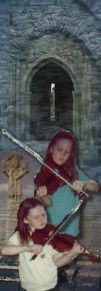





















|


Kilrush Heritage Centre
"Kilrush in Landlord Times" depicts the story of Kilrush from its establishment
as an Estate Town by the Vandeleur Landlords at the end of the 18th Century.
Starting point of a heritage walk through the streets of Kilrush.
Open daily, Jun. to Sept.
Clare Archaeology Centre
Dysert O'Dea Castle, Corofin
Home of the O'Dea Clan until 1691, this castle is situated in one of the richest
archaeological areas in Europe.
Open daily, May to Sept.
Clare Heritage Genealogical Centre
Portrays the traumatic period of Irish Culture, which includes famine and
emigration. It offers a professional genealogical service to persons wishing
to trace their ancestry.
Open year round.
Craggaunowen
The Living Past, near Ouin
Ireland's original prize-winning centre dedicated to interpreting the Pre-historic
and early Christian eras. Exhibits range from Bronze Age homesteads to Celtic
Chieftain's residences.
The "Brendan" boat is located here.
Coffee shop.
Open daily, Mar. to Oct. and during the weekends of Nov. to Feb.
Museums in Limerick
The city boasts two museums, one in the beautifully restored Georgian John's
Square and the Hunt Museum at the National Institute of Higher Education
complex at Plassy. There is guide literature available at the tourist office in
Arthur's Quay.
Bunratty Folk Park
The folk park in the castle grounds gives visitors a glimpse of traditional lifestyles
in the Shannon region. It features a complete reconstruction of a 19th century village
street, including craft shops, general stores and post office. There are examples
of houses representing a variety of districts from west Clare to the rich farmlands
of Limerick. Traditional crafts of an earlier age may be observed in action basket
weaving, farriery, candle making and the home-baking of bread.
A collection of early agricultural machinery is also on show. In the folk barn country
style meals are served and entertainment provided music, story-telling, Irish
dancing and songs.
Aughrim Interpretive Centre
Tells the story of the Battle of Aughrim and its significance in Ireland and
Europe. The Centre is open Easter to October, seven days a week.
July 12th, 1691 saw 20,000 men in the Williamite (King William of Orange)
army fight an equal number of Catholic Irish and French Jacobites, under the
French general, St. Ruth, in what was to be the last great land battle in Ireland.
After the bloodiest battle ever fought on Irish soil the Williamites emerged
victorious thus curtailing the ambitions of King Louis XIV of France in Europe.
|
|

















|

